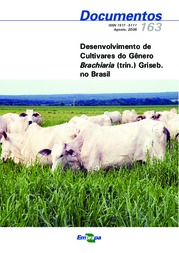Desenvolvimento de cultivares do gênero Brachiaria (trin.) Griseb no Brasil.
Desenvolvimento de cultivares do gênero Brachiaria (trin.) Griseb no Brasil.
Author(s): KARIA, C. T.; DUARTE, J. B.; ARAÚJO, A. C. G. de
Summary: In Brazil, cultivated pastures cover more than 100 million hectares and Brachiaria species cover more than 45 million hectares. B. brizantha cv. Marandu and B. decumbens cv. Basilisk are the primary cultivars. The large areas occupied by the same cultivars pose a vulnerability to the beef cattle activity, and make clear how necessary is to increase the genetic diversity of forage cultivars. Most of Brachiaria species show the apomitic mode of reproduction, with seeds containing an embryo with assexual origin. The apomixis limits the use of the hybridization in the genetic breeding program. However, the induced duplication of the chromosomes of the sexual diploid B. ruziziensis, and the identification of sexual diploid B. brizantha and B. decumbens genotypes enabled the use of intra and interspecific genetic recombination for the improvement of these species. In this review, it is presented a historical briefing about Brachiaria cultivars developed by Embrapa, the description of some aspects on the genetics of Brachiaria, some strategies adopted by this breeding program, and the related researches that have been performed in Brazil.
Publication year: 2006
Types of publication: Books
Unit: Embrapa Cerrados
Keywords: Apomixia, Brachiaria, Braquiária, Brasil, Capim Brachiaria, Citogenética Vegetal, Feed crops, Feed grasses, Germoplasma, Gramínea Forrageira, Hibridação, Hibridization, Historia, Melhoramento Genético Vegetal, Pastagem, Pesquisa, Planta Forrageira, Reprodução, Variedade, pastures, plant breeding, varieties
Observation
Some of Embrapa's publications are published as ePub files. To read them, use or download one of the following free software options to your computer or mobile device. Android: Google Play Books; IOS: iBooks; Windows and Linux: Calibre.
Access other publications
Access the Agricultural Research Database (BDPA) to consult Embrapa's full library collection and records.
Visit Embrapa Bookstore to purchase books and other publications sold by Embrapa.

